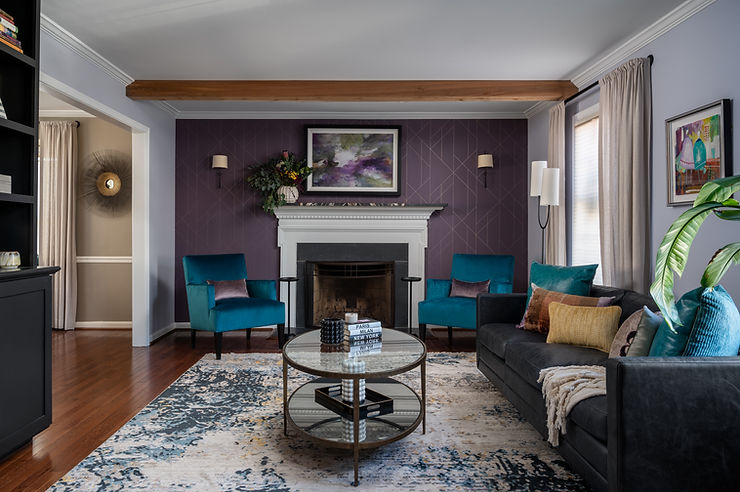10 Interior Designer Tips for Maximizing Natural Light in Your Home
- info6647604

- Sep 2, 2024
- 4 min read
Maximizing natural light in your home is one of the most effective ways to create a bright, inviting, and energy-efficient space. At Thereron Design Studio, we specialize in providing interior design services in Washington, and we understand the transformative power of natural light. Whether you're looking to enhance a small room or brighten up an entire home, these expert tips will help you make the most of the natural light available in your space.

The Benefits of Natural Light
Natural light is more than just a design element; it’s essential for a healthy, vibrant home. Sunlight improves your mood, increases productivity, and even helps regulate sleep patterns. Moreover, utilizing natural light reduces your dependence on artificial lighting, leading to lower energy bills and a smaller carbon footprint. Here are ten interior design tips to help you maximize natural light in your home.
1. Use Light Colors on Walls and Ceilings
One of the most effective ways to enhance natural light is by choosing the right paint colors. Light colors, especially white, reflect more light than darker shades, making rooms appear brighter and more spacious. For ceilings, opt for white or a shade slightly lighter than your walls to create the illusion of height and openness.
In rooms that receive little natural light, consider using a glossy or satin finish on the walls to further enhance light reflection.
2. Incorporate Mirrors Strategically
Mirrors are a powerful tool in interior design, particularly when it comes to maximizing natural light. By placing mirrors opposite or adjacent to windows, you can reflect light deeper into the room, making the space feel brighter and larger.
Large, decorative mirrors not only amplify light but also serve as stunning focal points in any room. Consider using mirrored furniture or accessories for an added touch of elegance.
3. Choose the Right Window Treatments
The type of window treatments you choose can significantly impact the amount of natural light that enters your home. Opt for sheer curtains or light-filtering blinds that allow sunlight to stream in while still providing privacy. If you prefer more coverage, consider layered treatments with a combination of sheer and opaque materials that can be adjusted throughout the day.
Avoid heavy, dark drapes that block light. If you need to use them, ensure they can be fully drawn back during the day to let in maximum light.
4. Keep Windows Clean and Clear
It may seem obvious, but dirty windows can significantly reduce the amount of natural light that enters your home. Regularly cleaning both the inside and outside of your windows will ensure that they allow in as much light as possible.
If possible, keep windowsills clear of clutter and opt for minimalist decor near windows to avoid obstructing light flow.
5. Opt for Light-Colored Flooring
Just like walls and ceilings, light-colored flooring can help reflect natural light throughout your home. Consider using materials like light oak, maple, or bamboo for wood floors, or choose light-colored tiles, carpets, or rugs.
6. Maximize Light with Glass Doors and Panels
Glass doors and panels are excellent for allowing light to pass from one room to another, especially in open-plan homes. Consider replacing solid interior doors with glass-paneled ones or adding glass transoms above doors to let light flow between rooms.
Frosted or textured glass can provide privacy while still allowing light to pass through, making it ideal for bathrooms or bedrooms.
7. Utilize Reflective Surfaces
In addition to mirrors, other reflective surfaces like glass tabletops, metallic fixtures, and glossy tiles can help bounce light around the room. These elements not only enhance the brightness of your space but also add a touch of sophistication.
8. Position Furniture Thoughtfully
The placement of your furniture can either enhance or obstruct the flow of natural light. Avoid placing large, bulky pieces of furniture in front of windows, as this can block light from entering the room. Instead, arrange furniture to allow light to move freely throughout the space.
Low-profile furniture can help maintain an open, airy feel, particularly in rooms with lower ceilings.
9. Add Skylights or Solar Tubes
For rooms that lack windows or have limited access to natural light, installing skylights or solar tubes can be an effective solution. Skylights bring in direct sunlight from above, while solar tubes channel light from the roof into otherwise dark areas of your home.
Skylights with adjustable shades or blinds offer flexibility, allowing you to control the amount of light entering the space.
10. Embrace Open Spaces
Finally, embracing an open floor plan is one of the best ways to maximize natural light in your home. Removing walls or widening doorways allows light to flow freely between rooms, creating a brighter and more connected living space.
If you’re not ready for a full remodel, consider using open shelving or glass partitions to create a more open, light-filled environment.
Maximizing natural light in your home is a game-changer when it comes to creating a welcoming, vibrant, and energy-efficient space. By incorporating these ten interior design tips, you can transform your home into a bright, airy haven that not only looks beautiful but also enhances your overall well-being. At Thereron Design Studio, we’re passionate about helping our clients in Washington achieve their design goals while prioritizing comfort, style, and sustainability. Whether you’re redesigning a single room or your entire home, these tips will help you make the most of the natural light available, creating a space you’ll love to live in.
Comments